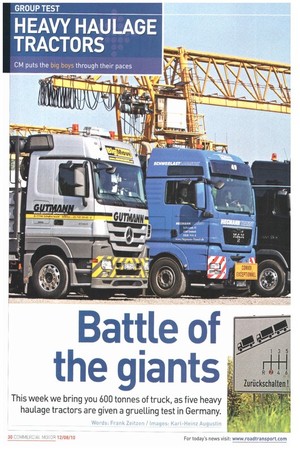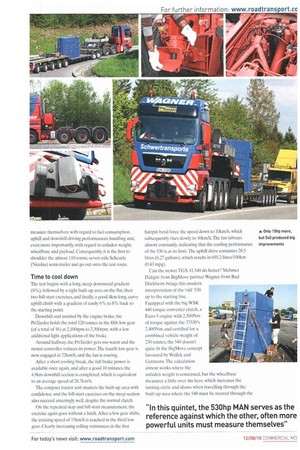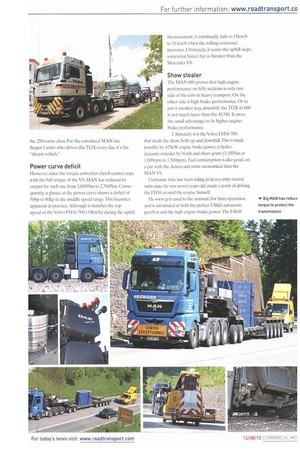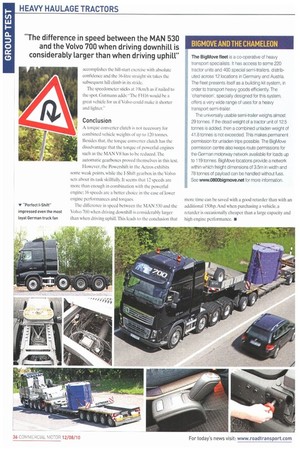attle of the giants
Page 30

Page 32

Page 33

Page 34

Page 35

Page 36

If you've noticed an error in this article please click here to report it so we can fix it.
This week we bring you 600 tonnes of truck, as five heavy haulage tractors are given a gruelling test in Germany.
Words: Frank Zeitzen / images: Kart-Heinz Augustin The casual listener might find it hard to believe. A dozen specialists are discussing heavy transport and the topics of conversation are payload. wheelbascs and trailer combination lengths, with no mention at first of the things that any uninformed bystander would expect to associate with heavy transport, such as horsepower, torque and traction.
"Apart from a few exceptions, we do not undertake 'extra-heavy transport' at 250 tonnes or more, but heavy transport with overall weights of 80 tonnes. 100 tonnes or 120 tonnes", says Horst Wallek, explaining the priorities for the discussion. The 4I-year-old is MD of Wallek Spe.zialtransporte from Garching, near Munich. and chairman of the hoard of BigMove, an 1I-company heavy transport co-operative (see box).
Important role
Mario Ci utmann, who is responsible for technology at BigMove. explains why the ostensibly inconspicuous variables, such as payload, length and wheelbase, play an important role: "We can make unladen trips without a police escort, without an accompanying vehicle fin Germany] and without additional permission, up to a length of 23m and up to 41.8 tonnes. We can only achieve that with four-axle vehicles with short wheelbases and low unladen weights"
So it has to he four-axle vehicles that are light and with a compact design. Hence, a light version of a heavy-duty tractor unit, which weighs around 12 tonnes, was developed in co-operation with MAN some five years ago. Of great importance is the dimension from the first to the third axle. It should be between 3,200mm and 3,300mm. Since all other dimensions are influenced by this one, it is considered to be the yardstick.
The right solution
In order to achieve the necessary low unladen weight, the tractor unit does without a torque converter clutch as well as a conventional retarder and must make do with a compact six-cy1Mder engine that develops 'only' 530hp. However, 530hp, a manual gearbox and a relatively small straight-six engine are no longer always the right solution for heavy transport nowadays.
In this quintet, the 530hp vehicle from MAN serves, in a manner of speaking, as the reference against which the other, often more powerful and modern tractor units must
measure themselves: with regard to fuel consumption. uphill and downhill driving performances. handling and, even more importantly, with regard to unladen weight, wheelbase and payload. Consequently, it is the first to shoulder the almost 110-tonne, seven-axle Scheurle (Nicolas) semi-trailer and go out onto the test route.
Time to cool down
The test begins with a long, steep downward gradient (8%). followed by a tight built-up area on the flat, then two hill-start exercises, and finally, a good 4km-long, curvy uphill climb with a gradient of easily 6% to 8% back to the starting point.
Downhill and assisted by the engine brake, the PriTarder holds the total 120 tonnes in the fifth low gear (of a total of 16) at 2,100rpm to 2,300rpm, with a few additional light applications of the brake.
Around halfway. the PriTarder gets too warm and the motor controller reduces its power.The fourth low gear is now engaged at 22km/h, and the fan is roaring.
After a short cooling break, the full brake power is available once again, and after a good 10 minutes, the 4.9km downhill section is completed, which is equivalent to an average speed of 28.7km/h.
The compact tractor unit masters the built-up area with confidence, and the hill-start exercises on the steep section also succeed amazingly well, despite the normal clutch.
On the repeated stop and hill-start measurement, the exercise again goes without a hitch. After a few gear shifts. the cruising speed of 15km/h is reached in the third low gear. Clearly increasing rolling resistances in the first — hairpin bend force the speed down to 10km/h. which A Only 10hp more, subsequently rises slowly to 16km/h.The fan labours but 540 produced big almost constantly, indicating that the cooling performance improvements
of the 530 is at its limit. The uphill drive consumes 28.5 litres (6.27 gallons), which results in 655.2 litres/100km (0.43 mpg).
Can the newer TGX 41540 do better? Mehmet Haligiir from BigMove partner Wagner from Bad Diirkheim brings this modern interpretation of the 'old' 530 up to the starting line.
Equipped with the big WSK 440 torque converter clutch, a Euro-5 engine with 2,500Nm of torque against the 37.530's 2,400Nm. and certified for a combined vehicle weight of 230 tonnes, the 540 doesn't quite lit the BigMove concept favoured by Wallek and Gutmann. The calculation almost works where the unladen weight is concerned, but the wheelbase measures a little over 4m here, which increases the turning circle and shows when travelling through the built-up area where the 540 must be steered through the
streets with greater care. Thanks to the retarder integrated in the torque converter clutch, the 41.540 is a minute faster on the downhill section mostly in sixth gear (of 12) and with 30km/h to 33km/h on the clock.
The hill-start exercise then shows how easy it is to set 120 tonnes in motion uphill. To put it briefly, with more weight. as is often the case with Wagner. you need a torque converter clutch.The 540 also does its job well uphill, climbing up the steep slope considerably faster and with hardly any more thirst. In figures: 29.1 litres (6.4 gallons) of diesel (equivalent to 669 litres/100km or 0.42 mpg) and 15km/h on average. The higher speed compared with the 530 does not result from the somewhat higher rated output, hut from the fact that the new six-cylinder engine in the 540 pulls with significantly more tenacity, although the rolling resistance increases considerably in hairpin turns. It holds its speed at 15km/h to 16km/h.
Higher unladen weight As with the light MAN 37.530,Gutmann specified several Actros 4160s.The four-axle vehicles jointly developed by Mercedes and Titan are based consistently on a short wheelbase (3,300mm) and the lightest possible design. The near 16-litre Mercedes 600 eight-cylinder engine with 2.800Nm is responsible for the somewhat higher unladen weight than the MAN 37.530. Merc's V6 and V8 SCR engines are generally considered to be economical, which was also confirmed in this comparison.
The Actros consumes somewhat more than the MAN 530 and less than the 540 and, compared with the pair of sixes, makes up some time both downhill and uphill.
The Powershift automatic gearbox is not entirely convincing. The accelerator pedal requires a sensitive touch during the hill-start exercise in order for the clutch to engage reliably. Nor does the gear-shift strategy quite fit the bill, as the Actros driver Karl-Heinz Rees confirms:-The automatic selects the gears better under load than without a load." As a result, he prefers to drive in manual mode.
The heaviest, but not the strongest vehicle in this quintet is the MAN TGX 41.680. Equipped with a WSK 440 torque converter clutch, MAN Tipmatic and a 16.2-litre VS, the vehicle from Munich qualifies itself for the 250-tonne class. For the convinced MAN fan. Jurgen Lanitz. who drives this TGX every day, its the -dream vehicle".
Power curve deficit
However, since the torque converter clutch cannot cope with the full torque of the V8. MAN has reduced its output for such use from 3,000Nm to 2,700Nm. Consequently, a glance at the power curve shows a deficit of 50hp to 60hp in the middle speed range. This becomes apparent in practice. Although it matches the top speed of the Volvo FH16-700 (19km/h) during the uphill measurement, it continually falls to 15km/h to 16 km/h when the rolling resistance increases. Ultimately, it scales the uphill slope somewhat faster, but is thirstier than the Mercedes VS.
Show stealer
"[be MAN 680 proves that high engine performance on hilly sections is only one side of the coin in heavy transport. On the other side is high brake performance. Or to put it another way, downhill, the TGX 41.680 is not much faster than the 41.540. It owes the small advantage to its higher enginebrake performance.
Ultimately it is the Volvo F1116-700 that steals the show both up and downhill.This is made possible by 425k W engine brake power, a hydrodynamic retarder hy Voith and sheer grunt (3,I50Nm at 1.000rpm to 1 .50Orpm). Fuel consumption is also good, on a par with the Actros and more economical than the MAN V8.
Gutmann, who has been riding in heavy-duty tractor units since he was seven years old, made a point of driving the Ffilb around the course himself.
Ile soon gets used to the unusual (for him) operation. and is astounded at both the perfect 1-Shift automatic gearbox and the high engine-brake power. The I-Shift accomplishes the hill-start exercise with absolute confidence and the 16-litre straight six takes the subsequent hill climb in its stride.
The speedometer sticks at 19km/h as if nailed to the spot. Gutmann adds: The FHI6 would be a great vehicle for us if Volvo could make it shorter and lighter.
Conclusion
A torque converter clutch is not necessary for combined vehicle weights of up to 120 tonnes. Besides that, the torque converter clutch has the disadvantage that the torque of powerful engines such as the MAN V8 has to he reduced. The automatic gearboxes proved themselves in this test. However, the Powershift in the Actros exhibits some weak points, while the 1-Shift gearbox in the Volvo sets about its task skillfully. It seems that 12 speeds are more than enough in combination with the powerful engine: 16 speeds are a better choice in the case of lower engine performances and torques.
-Perfect I-Shift" The difference in speed between the MAN 530 and the impressed even the most Volvo 700 when driving downhill is considerably larger loyaL German truck fan than when driving uphill.This leads to the conclusion that more time can be saved with a good retarder than with an additional 150hp. And when purchasing a vehicle, a retarder is occasionally cheaper than a large capacity and high engine performance. •








































































































































